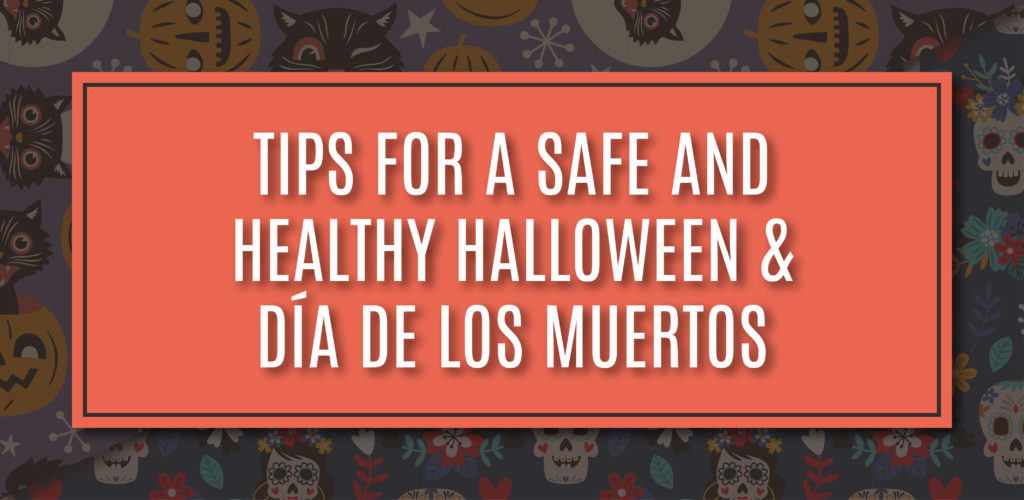Tips For A Safe And Healthy Halloween & Día De Los Muertos (Dead Of The Dead)

We know, it has been said over and over again, this year looks different than most years, especially when it comes to holidays and events. Just because it’s 2020, Halloween or Día de los Muertos are not cancelled but instead should look different for the safety of yourself, your family, your sisters and our communities.
Below you can find low-risk and moderate-risk activities provided by the CDC, along with some high-risk activities to avoid. We suggest taking these options and adapting them to work for you and your roommates/family or small group of sisters/friends in outdoor areas. It is also vital to abide by all campus, local and state guidelines.
Halloween
Low-Risk Activities
- Carving or decorating pumpkins with roommates and displaying them
- Carving or decorating pumpkins outside, at a safe distance, with sisters or friends
- Decorating your house, apartment, or living space
- Doing a Halloween outdoor scavenger hunt
- Having a virtual Halloween costume contest
- Having a Halloween movie night with people you live with, or virtually
- Having a scavenger hunt style trick-or-treat search with your household members in or around your home rather than going house to house
Moderate-Risk Activities
- Participating in one-way trick-or-treating where individually wrapped goodie bags are lined up for sisters or friends to grab and go while continuing to social distance (such as at the end of a driveway or at the edge of a yard)
- If you are preparing goodie bags, wash your hands with soap and water for at least 20 second before and after preparing the bags.
- Having a small group, outdoor, open-air costume parade where people are distanced more than 6 feet apart
- Do not wear a costume mask over a protective cloth mask because it can be dangerous if the costume mask makes it hard to breathe. Instead, consider using a Halloween-themed cloth mask.
- A costume mask (such as for Halloween) is not a substitute for a cloth
- Attending a costume party held outdoors where protective face masks are worn and people can remain more than 6 feet apart
- This should follow university, local and state guidelines as far as how many people are allowed in outdoor gatherings and everyone should remain socially distanced.
- Going to an open-air, one-way, walk-through haunted forest where appropriate mask use is enforced, and people can remain more than 6 feet apart
- If screaming will likely occur, greater distancing is advised. The greater the distance, the lower the risk of spreading a respiratory virus.
- Visiting pumpkin patches or orchards where people use hand sanitizer before touching pumpkins or picking apples, wearing masks is encouraged or could be enforced, and people are able to maintain social distance
- Having an outdoor Halloween movie night with local family and friends with people spaced at least 6 feet apart
- Lower your risk by following CDC’s recommendations on hosting gatherings or cook-outs.
High-Risk Activities
- Participating in traditional trick-or-treating where treats are handed to children who go door-to-door
- Having trunk-or-treat where treats are handed out from trunks of cars lined up in large parking lots
- Attending crowded costume parties held indoors
- The worst thing to do during these times is attend a crowded party at an apartment or home.
- Going to an indoor haunted house where people may be crowded together and screaming
- Going on hayrides or tractor rides with people who are not in your household
- Using alcohol or drugs, which can cloud judgement and increase risky behaviors
- Traveling to a rural fall festival that is not in your community if you live in an area with community spread of COVID-19
Día de los Muertos (Day of the Dead)
Low-Risk Activities
- Preparing traditional family recipes for family and neighbors, especially those at higher risk of severe illness from COVID-19, and delivering them in a way that doesn’t involve contact with others
- Playing music in your home that your deceased loved ones enjoyed
- Making and decorating masks or making an altar for the deceased
- Setting out pillows and blankets in your home for the deceased
- Joining a virtual get-together celebration
Moderate-Risk Activities
- Having a small group outdoor, open-air parade where people are distanced more than 6 feet apart
- Visiting and decorating graves of loved ones with household members only and keeping more than 6 feet away from others who may be in the area
- Hosting or attending a small dinner with local family and friends outdoors where people are distanced more than 6 feet part
- Lower your risk by following CDC’s recommendations on hosting gatherings or cook-outs.
High-Risk Activities
- Attending large indoor celebrations with singing or chanting
- Participating in crowded indoor gatherings or events
- Having a large dinner party with people from different households coming from different geographic locations
- Using alcohol or drugs, which can cloud judgement and increase risky behaviors
For those sisters who do not know, Día de los Muertos (Day of the Dead) is a two-day celebration originated in Mexico and is celebrated on November 1st and 2nd. It is sometimes confused with Halloween because of the symbolic skulls but is not related at all. According to https://dayofthedead.holiday/history/ it is said that on November 1st the children who have passed come back to visit and celebrate as angelitos and on the following day, November 2nd, it’s the adults (Difuntos) turn to show up for the festivities. Family members prepare for several weeks in advance for the tradition by creating altars, decorating burial sites, and cooking specific Day of the Dead food.
Sources:

